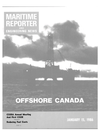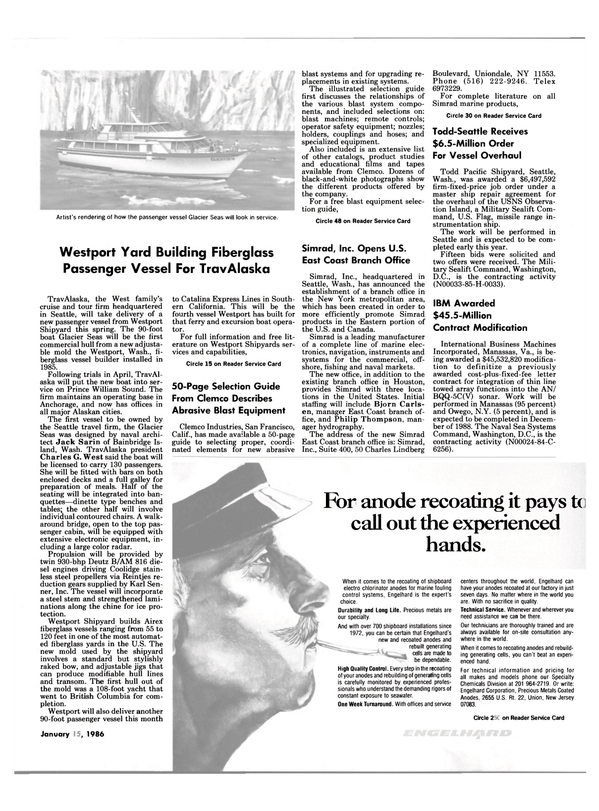
$5-Billion Hibernia Offshore Project Will Get Under Way Early This Year
First construction related to Newfoundland's $5-billion Hibernia offshore oil project is scheduled to begin in the first quarter of 1986, it was announced in New York recently by Hal Barrett, Minister of Development and Tourism for the Canadian Provence.
According to Minister Barrett, the Hibernia project offers opportunities for U.S. and other countries.
"Joint venturing is the key to American involvement in Newfoundland," he said. "The international community has already started to enter the local scene, with major offshore players such as Norwegian Contractors and Moss Rosenberg of Norway; McDermott International and Brown & Root of the U.S.; and C.G. Doris of France all entering into agreements to form joint ventures." The first major discovery in Hibernia Field was made in 1979 by Chevron while drilling on Mobil Oil's acreage. This field is said to be the third largest offshore oil discovery made in the world to date, with only two fields in the North Sea being larger. A total of nine wells have been drilled at this site, confirming the existence of a commercially exploitable field of close to a billion barrels of recoverable oil and two trillion cubic feet of natural gas.
The Hibernia Field will be developed by Mobil Oil utilizing a concrete, gravity-based production platform; it is anticipated that oil will start to come ashore by 1991 or 1992. Prior to the production phase, however, an incredible amount of industrial activity is slated to occur.
The work that will begin this year involves the construction of two major facilities in Newfoundland for the fabrication, outfitting, and actual construction of a concrete production platform. It should take about 18 months to fully develop the construction site, and an additional three years to construct, outfit, commission, and situate the platform at the Hibernia Field. Approximately the same time frame is required to establish facilities for construction related to the abovewater elements of the platform.
The concrete base of the production platform that Mobil will utilize in developing this oil resource is so massive that realistically it can only be built in Newfoundland. Such a structure is not designed to be towed a long distance. The entire project is comparable to constructing a 40-story building in a deepwater habor, floating it almost 200 miles offshore in the North Atlantic, and then resting it on the bottom of the ocean.
While there are concrete oil production platforms in use in the North Sea fields, none of those are comparable in size to the structure that will be built for Mobil's Hibernia project. The concrete base of the structure will be about 280 feet high with a diameter at the base of 344.5 feet. It will require 70,000 tons of cement and incorporate some 50,000 tons of reinforcing steel.
The above-water part of the structure, measuring about 300 feet on each side, will consist of three levels—a cellar deck, module deck containing accommodations, and weather deck topped by the drilling rig and helicopter platform. Water depth at the site is 262.5 feet (80 meters).
Of the $5-billion total cost of the Hibernia project, including the development of onshore facilities, some 50 percent is estimated by the Canadian Shipbuilding and Ship Repair Association to be marinerelated.
And this entire project is designed for the development of just one oil field.
There are several other commercial deposits of oil offshore Newfoundland that have been discovered in recent months, including a discovery at the North Ben Nevis Field by a Canadian company, Husky/ Bow Valley Limited. Plans for the development of this field are now being formulated, and oil could be flowing from Ben Nevis as early as 1990 if the company decides to utilize a floating production system.
Several months ago Petro Cana- da, the national oil company, announced a discovery at another field known as Terra Nova. In addition, there are at least seven other commercially exploitable oil fields and several more natural gas deposits that have been identified off the coast of Newfoundland. In the interim, exploration, seismic work, and delineation drilling offshore are continuing apace.
All this offshore activity has spurred a considerable amount of development onshore in Newfoundland, especially in the capital city of St.
John's. At present there are several major construction projects under way in the capital that total close to $100 million. A convention center/ hotel complex is being built, Manufacturers Life Assurance Company has started the first phase of a three-phase office complex, a major Canadian bank is constructing a new office and banking complex valued at approximately $30 million, and another $8-million office building is under construction.
Outside the capital, onshore developments include an $ll-million oil rig servicing facility and the sites being prepared for the construction of the Mobil concrete platform, as well as other major developments either planned or in progress estimated to total approximately $100 million in expenditures.
Almost $100 million has been invested recently in two major marine research establishments in Newfoundland— the $56-million Institute for Marine Dynamics, one of the largest hydrodynamic centers in the world featuring the largest ice tank in the world; and the $42-million Newfoundland Institute of Fisheries and Marine Technology.
Read $5-Billion Hibernia Offshore Project Will Get Under Way Early This Year in Pdf, Flash or Html5 edition of January 15, 1986 Maritime Reporter
Other stories from January 15, 1986 issue
Content
- Bay Shipbuilding Expands Foreign Trade Zone page: 5
- Gladding-Hearn Shipbuilding To Build Large, Fast Passenger Catamarans On The East Coast page: 6
- Free Literature Describes New Repair Compounds From Philadelphia Resins page: 6
- ODECO Elects Kilpatrick Executive Vice President page: 6
- Combustion Engineering A w a r d e d $12 Million In Navy Boiler Contracts page: 7
- Huthnance Consolidates Management Of Nine Offshore Drilling Rigs page: 7
- Hagglunds Offers Elaborate 72-Page Full-Color Booklet On Cranes And Equipment page: 7
- Navy Ends Suspension; Tracor, Inc., Resumes Government Contracting page: 8
- ' 85 Sales Of Imperial Survival Suits Nears 100,000 page: 8
- Aalborg Yard Launches Third Reefer For Delivery To USSR's Sudoimport page: 8
- 38th Annual CSSRA Conference And First Canadian Shipbuilding & Offshore Exhibition page: 12
- $5-Billion Hibernia Offshore Project Will Get Under Way Early This Year page: 13
- Major Manufacturers Attend First Diesel Propulsion Conference Held In Seat page: 14
- Roger Nejes Appointed Assistant To President, Todd Shipyards Corp. page: 14
- Armco Continues To Upgrade Speciality Steels Facilities page: 14
- Westport Yard Building Fiberglass Passenger Vessel For TravAlaska page: 15
- Simrad, Inc. Opens U.S. East Coast Branch Office page: 15
- Balehi Marine Christens Twin-Screw Harbor Utility Boat page: 16
- Fast Sealift Ship USNS Altair Dedicated At Avondale Industries Shipyard Division page: 16
- Fincantieri Completes Major Overhauls On Two RO/RO-Containerships page: 17
- Shelley To Succeed Holmes As President Of Raytheon page: 17
- Ingersoll-Rand Purchases Fafnir Bearing Division page: 17
- McDermott Gets $48-Million Offshore Contract From Chinese Petroleum Corporation page: 18
- Pool Arctic Alaska Orders Bardex Hydranautics Island Rig Skidding System page: 18
- Bay Shipbuilding Lays Keel For Second Of Three Containerships page: 18
- Omnithrusters Delivered For Canadian Government Vessels page: 18
- Ingram Barge Completes Organization Changes— Reports Rapid G r o w th page: 19
- Optimizing Efficiency Levels Of Boiler Feed Turbo Pumps page: 20
- Russellstoll Offers Full-Color Bulletin On Heliport Lighting System page: 20
- Nichols Brothers Delivering Catamaran To Glacier Bay Yachts page: 21
- Simultaneous Drydocking Requires Separation Of 70,000-Ton Drydock At Penn Ship page: 21
- REDUCING FUEL COSTS page: 24
- BP Offers 60-Page Brochure On Facilities/Capabilities page: 28
- Farboil Offers Two Free Directories On Marine Coatings and Systems page: 28
- Todd Galveston Awarded $21.6-Million Modification Of Second T-AVB Vessel page: 28
- PNOC Marine And Bardex Hydranautics Build World Class Shipyard page: 29
- Gems Sensors Expands Line Of Level Indicators page: 29
- White Named Senior Vice President At American Systems Engineering page: 29
- Karl Senner Offers Sales And Service For Reintjes Marine Gears page: 30
- DDA Offers Expanded Product Line And Streamlined Manufacturing Facilities page: 30
- Steamship Company Chief Given Top Federal Academy Alumni A w a rd page: 31
- New Marine Overcoat Sea-Slide™ Increases Speed, Saves Fuel page: 31
- Valley Line Reorganizes And Expands Marketing Department— Three N e w Executives Join Firm page: 31
- First Lucander-Designed Tug Nozzle Built By ideal Machine page: 31
- American Metal Bearing's Rubber Bearing Staves Approved By Navy page: 32
- Brochure Explains N e w USCG Survival Suit Regulations page: 32
- Saab Electronics Introduces TankRadar page: 33
- Alden Electronics Introduces Tactical Facsimile Receiver page: 33
- Furuno Introduces Digitized Small Radar page: 33
- Offshore Triple-Effect Water Makers From Atlas-Danmark Save Thousands In Operating Expenses page: 34
- Acoustical Barrier Material Data Sheet Available page: 34
- Robertshaw Literature Describes Versatile Diaphragm Actuators page: 34
- Gladding-Hearn Delivers Two Tugs To Bermuda's Department Of Marine page: 34
- Belgian Shipbuilder "Floats7 Massive GRP Mold On Film Of Air page: 36
- Navigation Sciences Offers VIEWNAV® Master Mariner Brochure page: 36
- Bailey Offers N e w Color Brochure On Recorders And Data Loggers page: 36
- Cummins Uprates B Series Marine Diesel Engines page: 38
- Titeflex Offers 22-Page Catalog On Smooth Bore Teflon Hose page: 38
- Cincinnati Gear Offers Free Color Brochure On Large Gears And Parts page: 38
- Baldt Offers New 12-Page Full-Color Facilities Brochure page: 38
- N e w Compact Thermocoil Diesel Fuel Heater From Racor page: 43


